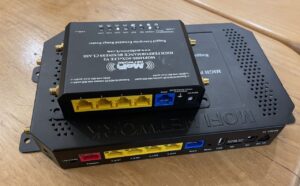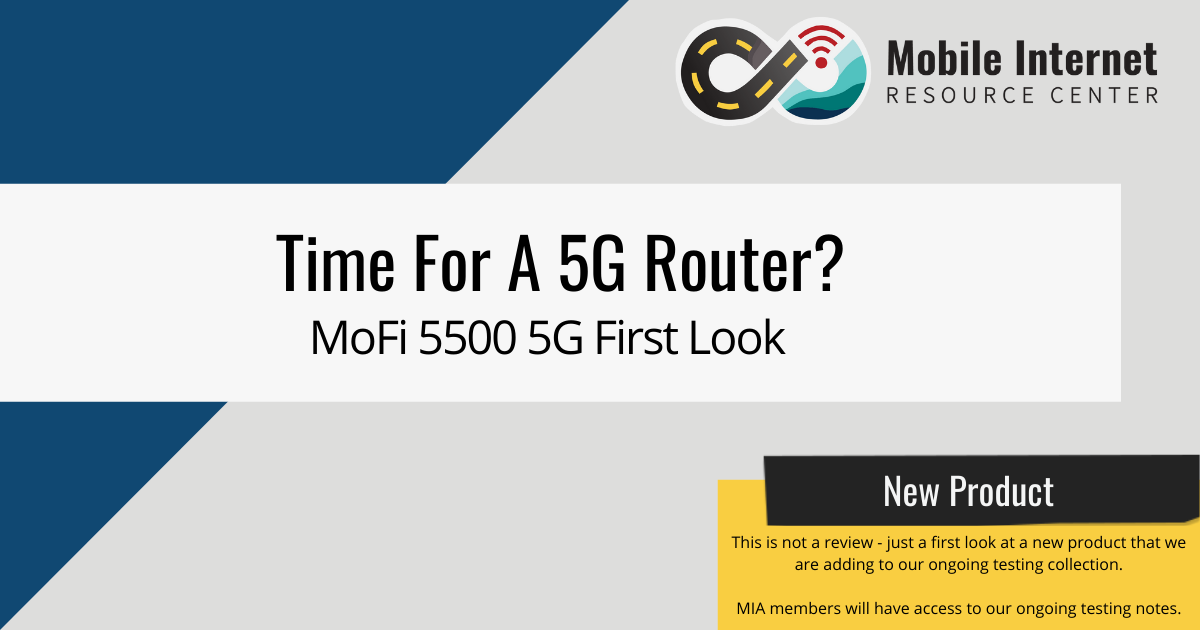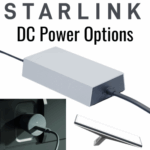
We just received the 5G version of the MoFi 5500 cellular integrated router, and now have had hands-on time with four very different 5G routers here at the Mobile Internet Resource Center:
- Pepwave MAX Transit 5G - This model incorporated a 5G modem module into the legacy MAX Transit chassis - and was the first 5G router we were able to experiment with when we received a test unit way back in March. This $999 model has already been discontinued.
- Insty Connect Explorer 5G20 - The Insty Connect uses a Quectel RM502Q-AE modem module, integrated into a cartridge right inside the outdoor “Angel Wings” 4x4 MIMO antenna - eliminating signal loss over antenna wires. The indoor router is then connected to the Angel Wings over USB. The Insty Connect Explorer 5G20 kit (antenna, modem, and router) sells for $999.
- Pepwave MAX BR1 Pro 5G - Peplink’s new single-modem 5G flagship costs $1,499, a huge step up from the MAX Transit 5G ($999). It uses a Sierra Wireless EM9191 5G modem module internally, which is based on the Qualcomm X55 modem chipset.
- MoFi 5500-5GXeLTE-EM9191 5G - MoFi’s flagship of the 5500 line costs just $699, and seems to be using the same Sierra Wireless modem module as the BR1 Pro 5G. At less than half the price of the Pepwave BR1 Pro 5G, the MoFi is a very compelling value - though it lacks some of the features and much of the refinement of a Pepwave router.
These are very different routers, with vastly different features, targeting very different segments of the market.
Are any of them worth investing in just yet?
Or is it smarter to keep waiting for 5G networks to continue to mature?
We've published a first look video focused on the MoFi 5500, and discussing the current state of 5G cellular routers at the end of 2021 - contrasting these very different approaches.
We have only just begun to experiment with the new MoFi - which features a vastly improved user interface compared to when we last tested the MoFi 5500 earlier this year.
Is it enough of an improvement to make the MoFi 5500 at last worthy of consideration?
And is the MoFi 5G model worth investing in, or should MoFi fans go for the Cat-20 4G version that costs just $499.
We will be sharing our ongoing testing notes with our MIA members as we dive into comparing the tradeoffs of these various options.
If you are not a member yet, please join us to go deeper!
Key Mobile Internet Related Considerations:
- AT&T and Verizon haven't yet begun to roll out truly next-generation-worthy 5G over much of the country, and the imminent C-Band 5G rollout that could make AT&T and Verizon 5G truly worthwhile is being delayed by concerns raised by the FAA. If you are primarily focused on Verizon or AT&T - there is little advantage in investing in 5G now.
- T-Mobile on the other hand is way ahead in rolling out nationwide low-band and mid-band 5G - so if you are on T-Mobile, investing in 5G gear could have an immediate and sometimes dramatic payoff.
- All of these routers are based on the Qualcomm X55 modem chipset - which is lacking in 5G carrier aggregation capabilities that will be very important in the future on all carriers. (See story for the deep details...)
- If you don't need to be on the bleeding edge (especially if you aren't using T-Mobile), waiting a generation for Qualcomm X60 powered routers will give the networks more time to evolve to make upgrading to 5G more truly worthwhile.
For More Information:
Related Content at the Mobile Internet Resource Center:
- Gear Center: MOFI5500-5GXeLTE by MoFi Networks
- Testing in Progress Forum: MoFi 5500-5GXeLTE (Cellular Embedded Router)
Related Updates:








 Mobile Internet Resource Center (dba Two Steps Beyond LLC) is founded by Chris & Cherie of
Mobile Internet Resource Center (dba Two Steps Beyond LLC) is founded by Chris & Cherie of